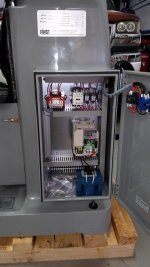atomarc
Diamond
- Joined
- Mar 16, 2009
- Location
- Eureka, CA
I'll pose this question even though the problem has seemed to have 'self healed'..how, I have no clue!
Hitchi WJ200 1hp drive with a external 200 watt-100 ohm braking resistor. This is on a small CNC machine that has several hours under its belt and stops instantly when commanded to.
Today the machine was fired up and the spindle run for approximately 15 minutes whereupon a burning- electrical smell was noticed. Investigating, the externally mounted braking resistor was found to be hot enough to burn your hand.
When disconnected it showed 'good' but the connection to the drive would show anywhere between 50 volts clear up to 300 volts and then trip on a braking module fault code.
All braking parameters were the same as they had always been from day one.
All brake functions were disabled and the trip did not return.
The connection from external resistor to drive was checked again and showed no erratic voltage so the resistor was reconnected and braking parameters were set to their previous values.
The spindle again stops instantly, no faults and the external resistor is as cool as a cucumber.
The drive has not been powered for several weeks but it resides in a sealed enclosure in a dry shop environment.
How can a solid state device like a VFD go nuts, then be OK?
Needless to say we are going to keep an eye on the braking resistor.
Any wisdom from the EE gurus!
Stuart
Hitchi WJ200 1hp drive with a external 200 watt-100 ohm braking resistor. This is on a small CNC machine that has several hours under its belt and stops instantly when commanded to.
Today the machine was fired up and the spindle run for approximately 15 minutes whereupon a burning- electrical smell was noticed. Investigating, the externally mounted braking resistor was found to be hot enough to burn your hand.
When disconnected it showed 'good' but the connection to the drive would show anywhere between 50 volts clear up to 300 volts and then trip on a braking module fault code.
All braking parameters were the same as they had always been from day one.
All brake functions were disabled and the trip did not return.
The connection from external resistor to drive was checked again and showed no erratic voltage so the resistor was reconnected and braking parameters were set to their previous values.
The spindle again stops instantly, no faults and the external resistor is as cool as a cucumber.
The drive has not been powered for several weeks but it resides in a sealed enclosure in a dry shop environment.
How can a solid state device like a VFD go nuts, then be OK?
Needless to say we are going to keep an eye on the braking resistor.
Any wisdom from the EE gurus!
Stuart


